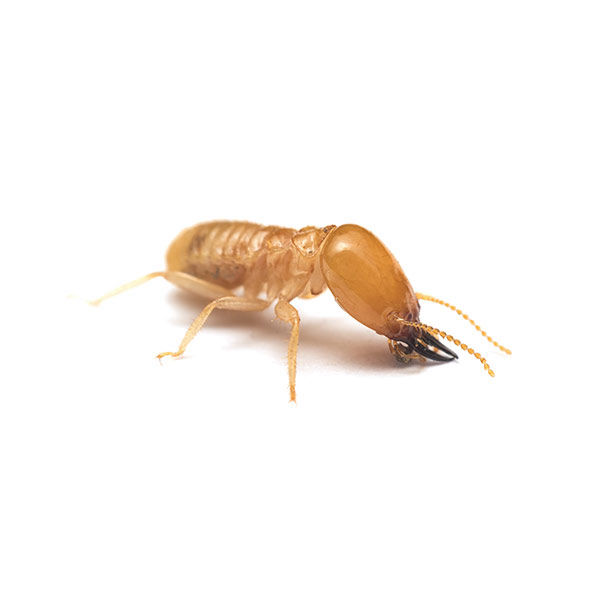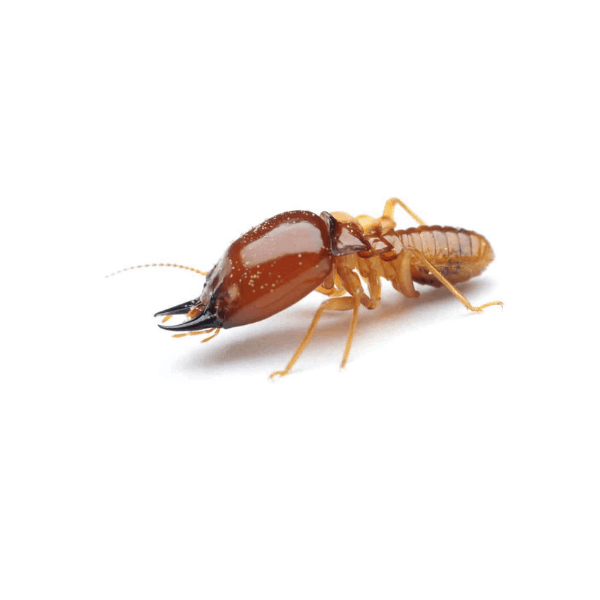Common Termites in Southern California

Subterranean Termites
FAMILY RHINOTERMITIDAE

Facts & Information


Similarly, subterranean termites differ in color by caste. Workers are cream-colored and pale. Soldiers are also this light color, but their heads are brown. Supplementary reproductives are this same, opaque shade, but primary reproductives are brown or black.
The size of subterranean termites depends on its caste. Workers measure one-eighth to three-eighths of an inch in length. Soldiers are as long as workers, but have larger heads with powerful mandibles. Both supplementary and primary reproductives measure about 1 inch in length.
The three main types of subterranean termites – workers, soldiers and swarmers – have specific jobs to do within the colony, and each is uniquely equipped with the tools they need to get the job done. Some termites have eyes. Some don't.
Workers:
No wings, about ¼ inch or less in length and cream colored.
Subterranean termite workers are small, opaque insects that can separate wood or other cellulose from its source. Workers live their entire lives in dark tunnels, both above and below ground. They do not have eyes because they do not need them. But, interestingly enough, they can still tell the difference between light and dark. They know being in the light means they are in danger of predator attacks, not to mention losing valuable moisture from their bodies. When worker termites find themselves in the light, they return to the dark as quickly as they can.
Swarmers:
Dark-brown to black in color, about ¼ to ½ inch long with two pairs of wings that are very close to being equal in length.
As the colony grows, supplementary termite queens help lay eggs and increase the size of the colony. Subterranean termite swarmers – another form of reproductive termites – develop when the colony is three to five years old and eventually leave the colony to start a new one of their own. These subterranean termites have eyes that are much more developed since they have to leave the security of the dark nest and mud tunnels. Out of all three types of termites, they’re the only ones that can see.
Soldiers:
No wings, large mandibles (jaws), termite colony defenders, are creamy-white in color, but their head is often brownish in color.
As their name indicates, subterranean termites live several feet below ground in bustling colonies.
Appearance of damaged wood:
Since subterranean termites build their nests underground, damaged wood usually has an accumulation of soil or mud within the tunnels of the wood they are eating. Since subterranean termites only eat the softwood, damaged wood appears to be layered, the result of the workers not eating the hardwood portion. In addition, subterranean termites feed “with the grain” rather than across the grain, as do drywood termites.
As their group name suggests, the nest is usually found below ground. Nests may be found above ground, but only when sufficient moisture conditions are available to support the above-ground nest and the colony is old and well established.
Termite attacks are subtle, often going undetected for many years. Over time, they can cause serious damage. Don’t wait for termites to show themselves. Trained specialists know where to look and what to do to keep termites out. They can give you the protection you need and the peace of mind you deserve.
For termite prevention:
- Store all firewood away from the home.
- Make sure four inches of the foundation is showing and no mulch is touching the home. Siding should not extend down into the soil.
- Keep drainage systems unblocked and routing water away from the home to prevent buildup.
- Eliminate leaks and moisture from the home in general.
Termite attacks are subtle, often going undetected for many years. Over time, they can cause serious damage. Don’t wait for termites to show themselves. Trained specialists know where to look and what to do to keep termites out. They can give you the protection you need and the peace of mind you deserve.
For termite prevention:
- Store all firewood away from the home.
- Make sure four inches of the foundation is showing and no mulch is touching the home. Siding should not extend down into the soil.
- Keep drainage systems unblocked and routing water away from the home to prevent buildup.
- Eliminate leaks and moisture from the home in general.
A drywood termite is usually pale brown, though it can vary between dark brown and light, yellowish-tan. Alates, or winged termites, have wings that can be clear or smokey gray in color.
Drywood termites are different sizes depending on their caste. Soldiers are typically three-eighths of an inch long. Reproductives (both male and female) measure one-half of an inch in length.
As with other species of termites, drywood termites are organized in a caste system. Once a queen finds a good spot for a colony (often in the rafters of a home), she chooses a mate (or king) and begins laying eggs. The eggs hatch and join the worker caste that eats (and damages) wood and cares for the rest of the colony. As the termite colony ages, some of the termites develop into reproductive or soldier castes. Reproductive termites will grow wings, swarm and go off to form new colonies. Soldier termites protect the established colony from ants, other termites and various threats.
Like other species of termites, this species eats cellulose, which is found in wood and other plants. This is what makes wooden structures so appealing to them and why they are found in homes, fences and trees. However, drywood termites eat across the grain which destroys both the soft springwood growth and the harder summerwood growth. Most subterranean termites avoid the harder layers of wood, eating only the softer layers. Because they eat across the grain, the tunneling can lead to a building or tree collapsing if the colony’s network of tunnels grows too extensive.
In the United States, drywood termites can be found in a narrow strip that runs roughly from Florida to California − warm to tropical climates where wooden structures are plentiful and winters are not severe.
A drywood termite likes to eat. And unlike its subterranean counterparts, it does not need moist soil or water nearby in order to thrive. Because they don’t need water, these termites are often found in dry wood above ground level. The wood they eat provides the moisture they need to survive, according to the AgriLifeExtension of the Texas A&M System.
As their group name suggests, the nest is usually found below ground. Nests may be found above ground, but only when sufficient moisture conditions are available to support the above-ground nest and the colony is old and well established.
Seeing a swarm of reproductive termites, which emerge from small holes in the wood, is a common sign of an infestation, according to the AgriLifeExtension at Texas A&M University. Other signs include blistering of the wood surface, because the termites tunnel too close to the surface, and pellets. Drywood termite pellets are usually the color of the wood they are eating. They are smaller than grains of rice and pile up around damaged wood. Pellets are also commonly found inside tunnels.
To control drywood termites, a pest management professional is needed. To reduce your home’s attractiveness to termites, you should:
- Keep firewood and other lumber away from your home’s foundation.
- Place fitted, type 20 mesh screen on all doors, windows, vents, openings, etc., especially ones that lead to attics and crawl spaces.
- Seal up any unfinished wood in, on and around your home. You can use paint, varnish or sealant, but make sure the coats are even and any nail holes or other cracks are sealed as well.